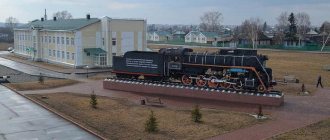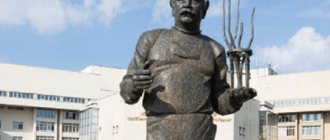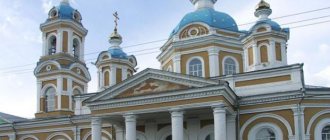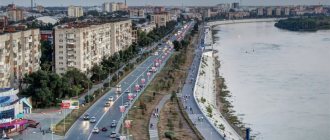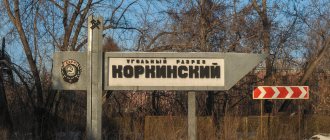Monument to customs officer Pavel Vereshchagin
The most famous monument of Kurgan. The bust of the hero of the film “White Sun of the Desert” is located near the Kurgan customs building.
The monument was erected on the initiative of the head of customs in 2007. The team supported the manager’s initiative, and the required amount was collected very quickly.
Address: st. Burova-Petrova, 132.
Monument Zero Kilometer
Many cities around the world have a similar monument. Residents of Kurgan decided: a monument to the Zero Kilometer should appear in their hometown. A bronze figure of a postman was installed in 2012 at the main post office. Now all roads are measured from this place.
The author of the project is local artist Boris Orekhov. Tourists often take pictures next to the postman.
Address: st. Gogol.
Monument to Parents
Another project implemented by the Mama Foundation with the support of the residents and authorities of Kurgan. A couple expecting a baby - this is what a monument to parents looks like. Young people are dancing. The beautiful bronze sculptural composition looks touching and tender.
Address: st. Gogol.
There are several interesting exhibitions in Kurgan. One of the museums attracts the attention of all tourists.
Kurgan Aviation Museum
This exposition is the only one in the Urals and Siberia. Aircraft of various brands are located in an open area near the airport. Visitors to the unusual museum will be able to see airplanes and helicopters from different production periods.
Address: st. Gagarina, 41.
There are places in Kurgan associated with the names of the Decembrists. Tourists will be interested in the exhibition of the house-museum of V. K. Kuchelbecker. The museum, which contains exhibits telling about the life of the Decembrist poet, is the only one in Russia. The exhibition is located on the street. Kuibysheva, 19.
What to see if you come with a child
The child will be interested in visiting the local Gulliver puppet theater. It began its work in the middle of the twentieth century, becoming one of the first such establishments in Russia. The performances here are quite diverse, based on both Russian and foreign fairy tales. There are performances for both very young spectators and adults.
Address: Sovetskaya street, house 104. Opening hours: daily, closed on Monday. Performances start: 11.00, 13.00 and 18.30. Ticket price: from 400 rubles.
There is also a Children's Railway for young travelers in Kurgan. The train departs from a special railway station, makes several stops, and passes through the central park, the banks of the Tobol River and the bridge. The length of the Children's Road is one and a half kilometers. The duties of a conductor, guide and assistant driver are performed by high school students.
Kurgan Children's Railway opened on August 13, 1989
Address: Kareltseva street, building 13. Opening hours: 10.00–21.00, Monday and Tuesday are days off. Cost of the trip: children - 50 rubles, adults - 100 rubles.
15 kilometers from Kurgan there is a small petting zoo “Forest Fairy Tale”, best known as the “Ostrich Farm”. Here the child will be able to look not only at ostriches - the main inhabitants of the farm, but also other animals, including: raccoons, rabbits, meerkats, peacocks, owls, ducks, piglets.
On the territory of the farm, you can have a great rest in nature by renting a cottage in a picturesque location
Address: Kurgan region, Ketovsky district, cottage village Roshchino. Opening hours: 10.00–19.00. Cost of visiting: children under 3 years old - free, children from 3 to 9 years old - 100 rubles, children from 10 years old and adults - 200 rubles.
Decembrists Museum
In 1975, an exhibition dedicated to the activities of the Decembrists opened in the city. The museum is located in the house where Colonel M.M. Naryshkin lived since 1832.
Letters have been preserved, thanks to which it was possible to restore the exact interiors of all rooms and the internal layout. The façade looks the same as it did in the 19th century. In the museum, visitors will be able to feel the breath of past years and see hundreds of interesting exhibits.
Address: st. Klimova, 80.
How to get there
There is an airport of the same name in Kurgan, which accepts flights from only one city - Moscow. There is one flight per day from the capital, the flight lasts almost three hours. Ticket price: from 8,000 rubles.
By train you can get to Kurgan from Moscow, Yekaterinburg, St. Petersburg, Novosibirsk, Belgorod, Petropavlovsk, Irkutsk, Omsk, Chelyabinsk, etc. The trip from Moscow will last 33–35 hours. Ticket price: from 1900 rubles. You can get from St. Petersburg to Kurgan by train in 46–47 hours. Ticket prices start from 4,000 rubles.
The station building was built at the end of the 19th century, but after numerous reconstructions it bears little resemblance to the construction of those years
Bus routes to Kurgan depart from Yekaterinburg, Nizhnevartovsk, Nizhny Tagil, Perm, Surgut, Tobolsk, Tyumen, Khanty-Mansiysk, Chelyabinsk and Shadrinsk. You can only get from Moscow and St. Petersburg by private car; buses do not go to Kurgan. A trip from St. Petersburg by personal vehicle will take about 30 hours, not including sleep. You will have to overcome 2700 kilometers. From the capital to Kurgan the distance is 2000 kilometers, which can be covered in 22 hours. You should travel along the M7, M5 and P254 highways.
Art Museum
Museum workers quite rightly believe that the collection collected within the walls of the museum is unique. There are no similar exhibitions in the Kurgan region, numbering thousands of works by contemporary artists from different regions of Russia.
Visitors will see paintings by N. Dormidontov, O. Sokolova, A. Deineka, G. Shegal and many other authors. The museum often hosts creative meetings and exhibitions dedicated to memorable dates in the history of Kurgan and the region.
Address: st. Maxim Gorky, 129.
A few words about Kurgan
Kurgan is a Russian city located on the banks of the Tobol River. The city is located in the Ural Federal District and plays the role of the administrative center of the Kurgan region. The area of the city is slightly less than 400 square kilometers. About 318 thousand people live here.
Kurgan is no longer the Urals, but also not Siberia; it is located in an area that has received the precise, beautiful name “Trans-Urals”
Story
The founder of the city is the peasant Timofey Nevezhin, who was the first to set up his hut on the Tobol River, not far from the ancient mounds. Later, other settlers began to come here from the central part of the country. So, in 1679, the first settlement was formed on the site of modern Kurgan. They called it the Tsar's Settlement. In 1695, the settlement moved down the river and changed its name to Tsarekurganskaya Sloboda. Then it became a military fortress, and in 1782, by decree of Catherine II, the settlement acquired the status of a city, and with it another name - Kurgan. Throughout the 19th century, the settlement played the role of the administrative center of the Kurgan district, part of the Tobolsk province. At the same time, the settlement begins to expand, the number of residents increases, hospitals, educational institutions, shops, libraries are opened, a railway and churches are built.
In general, the first settlements on the site of the Kurgan appeared about a thousand years BC. Once upon a time, the leader of the Scythian-Sarmatian tribe was buried here, however, unfortunately, all the ancient graves in these places have long been plundered
The city acquired its modern appearance in the post-war period. In the middle of the twentieth century, the famous center of G. A. Ilizarov opened here, in addition, new residential buildings were erected in the settlement, factories and an aviation school were opened. In 1998, the city acquired a flag and coat of arms, which are still in use today. Today Kurgan is a relatively large industrial center of Russia, as well as an economic, transport, cultural, business and trading city of the Urals.
Kurgan Museum of Local Lore
The museum's exposition is one of the richest in the vastness of Siberia and the Urals. More than 200 thousand valuable exhibits cover the period from the primitive system to the present.
Thematic exhibitions are organized in the halls of the museum, which contain archaeological and paleontological finds, ancient manuscripts, silver and metal jewelry, ancient weapons, household items, photographs and archival documents.
You can spend the whole day in the halls of the museum. Come early. The museum is open from 9 a.m. to 5 p.m. Monday is a day off.
Address: st. Pushkina, 137.
Kurgan Cathedral of Alexander Nevsky
This cultural and architectural landmark of Kurgan is located in its very heart. Built at the beginning of the twentieth century with public money, the majestic Alexander Nevsky Cathedral remains the only one of the three Orthodox churches that existed in the city a hundred years ago. This ancient building miraculously survived the revolution, the war, and the years of stagnation. It was closed for a long period, then, starting in 1951, the exposition of the regional museum of local history was located here, and only in 1991 the temple was finally returned to the Kurgan believers.
City History Museum
Visit the merchant mansion that belonged to the merchant of the 1st guild S.I. Berezin. This stone urban-type estate is the only one in the vast Trans-Urals that has preserved an enclosed courtyard with a central house and outbuildings.
The 19th-century estate contains documents, photographs of city streets, and personal belongings that belonged to famous citizens. Visit the museum on the street. Kuibysheva. On the same street there is the house-museum of the Decembrist V.K. Kuchelbecker.
Address: st. Kuibysheva, 59.
Presentation “Architecture of Kurgan”
Explanatory note for the presentation “ARCHITECTURE OF THE KURGAN”
1 slide. Architecture of Kurgan.
2 slide
. The history of the city of Kurgan originates from the settlement of Tsarevo Gorodishche. It was founded in 1679 by the investor of the Dalmatovsky Assumption Monastery Timofey Nevezhin at the foot of the ancient mounds. In 1782, in connection with the formation of the Tobolsk province, by Decree of Empress Catherine II, the settlement received the status of a city with the name Kurgan.
In 1785, the city was assigned a coat of arms, the description of which said: “... in a green field there are two silver mounds: after the name of this city and as a sign that they are located near the city itself.”
During tsarist times, the small town became a place of exile. He saw Polish rebels, Decembrists, Narodnaya Volya. The history of the city changed after the construction of the Great Siberian Railway, which ran through Kurgan in 1894. From a quiet county town by the beginning of the 20th century. Kurgan turned into one of the large commercial and industrial centers of the Urals and Siberia, known outside the Russian Empire.
The Kurgan region took its place on the map of Russia during the Great Patriotic War. On February 6, 1943, the city of Kurgan became the administrative center of the newly created Kurgan region.
For success in economic activity in 1982, Kurgan was awarded the Order of the Red Labor
Banner.
3 slide
. Modern Kurgan is a city covering an area of 372 km², with a population of about 340 thousand people. In recent years, new residential neighborhoods, multi-story high-rise buildings, shopping and entertainment centers, and sports facilities have been built here.
The city's architecture successfully combines styles from different eras. The central part of the city is decorated with monuments
history and architecture of the 18th-20th centuries: merchant houses and estates, monuments of wooden architecture,
Cathedral of St. Alexander Nevsky. The visiting card of the city is the architectural ensemble of the Central Square of Kurgan, created in the 50s of the 20th century. Leningrad architects and designers. There are many beautiful and unique places in Kurgan that are treasured by residents and admired by visitors. Every corner here has its own history.
4 slide. Historical and architectural monuments
5 slide. Administrative building of the distillery of D. I. Smolin
Kuibysheva, 122
The house was built in 1884 according to the design of the architect Yu. I. Ivashev. One building housed residential
house and office of a distillery with a store. The owner of the house was the founder of the family, one of the richest Trans-Ural merchants, Dmitry Ivanovich Smolin. The decor of the main facade consists of small
details reproducing the motifs of Russian wooden carvings, translated into stone. The site is currently being redeveloped. A recreation area has been organized on the site of the former courtyard, and a park has been laid out in front of the house. The building houses a branch of a yeast production company.
6 slide. House of A. A. Danilushkin
M. Gorky, 170
The building belonged to a well-known contractor in Kurgan, Andrei Abramovich Danilushkin. The building in the Russian style, unique for the architecture of Kurgan, was built in 1882. The decoration of the facade is characterized by the use of motifs borrowed from ancient Russian architecture.
Slide 7
House of the Decembrist A.E. Rosen
Sovetskaya, 67
The estate was built at the beginning of the 19th century, and in 1833 it was acquired by the Decembrist Andrei Evgenievich
Rosen, who is settling in Kurgan with his family. Since the end of 1890, the house housed the Public Assembly, which after the revolution was renamed the People's House. Now in the house of the Decembrist
Rosen is the Children's Art School No. 1.
8 slide. House of engineer F. F. Ostapets
Pushkina, 85
The elegant structure is an example of a residential log house made in the Art Nouveau style.
Erected by order of retired warrant officer Fyodor Fedorovich Ostapts at the beginning of the 20th century. Now in the house
The City Culture and Leisure Center is located.
Slide 9 House of merchant K. M. Dunaev
Klimova, 47
A unique example of a chopped wooden house. The building is distinguished by a façade decor with many
small carved parts. Built in 1906 by merchant Konstantin Markovich Dunaev. The building was restored in 1980. Now it houses the art department of Children's Art School No. 1.
10 slide. Fire station
Kuibysheva, 62
firebrigade9.narod.ru
The fire department building was built in 1882. In 1998, a wooden tower 27 meters high,
previously destroyed, it again decorated the fire station and gave it architectural completeness. Today, the tower, like the building itself, is an architectural monument and one of the symbols of the city of Kurgan.
11 slide. Union of Siberian Butter-Making Artels
Kuibysheva, 57
At the beginning of the 20th century. the house belonged to the merchant Pavel Vasilyevich Sokolov. Since 1912 it was located here
Union of Siberian butter-making artels, founded in 1907 by merchant Alexander Nikolaevich
Balakshin.
12 slide.
Photo by I. M. Babykin
Kuibyshev, 65
In 1927, the house housed the salon of the talented photographer Ippolit Mikhailovich Babykin.
Currently, the house has been restored according to drawings from the early 20th century. To this day, there is Photograph No. 1 of the city of Kurgan and a museum of the history of photography.
Slide 13 Cathedral of St. Alexander Nevsky
Volodarsky, 42
The Alexander Nevsky Church is considered one of the most beautiful buildings in the city and is listed in
Encyclopedia Britannica as an outstanding architectural monument. Construction of the church has begun
in 1896 according to the design of the talented Kurgan architect N. A. Yushkov. In 1929 the church was closed,
and in 1991 it again opened its doors to parishioners.
Slide 14 Museums
Slide 15 Regional Museum of Local Lore
Pushkina, 137 (+7 gukokm.narod.ru
The largest repository of historical, cultural and natural science collections in the Kurgan region. The museum has over 200 thousand museum objects. These are 40 collections covering the period from the primitive communal system to the present day. Unique exhibits of regional and federal significance are presented. The museum includes branches: the Decembrist House Museum, the V. K. Kuchelbecker House Museum, the City History Museum, the Aviation Museum and the T. S. Maltsev House Museum, located in the village of Maltsevo, Shadrinsky district, Kurgan region.
16 slide. House-Museum of the Decembrists
Klimova, 80 A (+7 gukokm.narod.ru
Opened in 1975 in the house where Decembrist Mikhail Mikhailovich Naryshkin lived since March 1832. The museum has restored the interiors of the owners' rooms, living room, dining room and library. The museum exhibits more than 2 thousand exhibits telling about the life of the Decembrists in Kurgan. One of the halls of the museum reveals the ideology of the Decembrist movement, tells about the uprising on Senate Square and the events that followed - the years of hard labor and imprisonment
Slide 17 Aviation Museum
Gagarina, 41a (airport) (+7 aviakurgan.narod.ru
Branch of the Kurgan Regional Museum of Local Lore. Founded in 1985. The museum building houses an exposition of the history of civil aviation, and on the museum grounds - military, civil and sports aviation equipment, which includes 14 aircraft. The Aviation Museum is the only museum of the Ministry of Culture of the Russian Federation of this profile. One of the most popular events of the museum is a large display of aviation equipment - “Open Cockpit Day”, which is held annually on City Day and Russian Air Fleet Day.
18 slide. Museum of the History of the City of Kurgan
Kuibysheva, 69 (+7 gukokm.narod.ru
The museum is located in a merchant mansion that belonged to the merchant of the 1st guild S. Berezin. Architectural monument of the 19th century. This is the only stone urban-type estate in the Trans-Urals that has preserved a closed courtyard with outbuildings and a central house in the style of Russian classicism. The museum exhibition reflects the political, economic, socio-cultural aspects of the development of Kurgan, starting from the founding of Tsarev Settlement until 1917, and also reveals the significance of the district town in the history of Siberia. A rare collection of photographs depicting the pre-revolutionary Kurgan, taken by the photographer of the last century A. Kocheshev, is presented in full.
Slide 19 Regional cultural and exhibition center
Gogolya, 30 (+7 okvc.kurganobl.ru
The center's activities consist of two directions: exhibition and cultural and leisure. The center hosts exhibitions of a wide thematic focus at the regional, Russian, and international levels; art exhibitions and anniversary expositions. Within the walls of the center there are clubs, lectures, master classes, creative meetings, theme evenings and presentations.
20 slide. Regional Art Museum
Gorky, 129 (+7 kohm.ru
The only museum in the region that has a collection of works by Russian artists of the 20th - early 21st centuries. The museum has a unique collection of watercolors, representing a 100-year period of its development. The decorative and applied arts section consists of works of traditional crafts of Russia and artistic crafts of the Trans-Ural region. Russian culture of the 18th - early 20th centuries. represented by icon painting, metal plastic, old printed and handwritten books. The museum conducts active exhibition activities and participates in the development and implementation of various scientific and educational projects.
21 slides. Theaters
22 slide. State Drama Theater
Gogolya, 58 (+7 kurgandrama.ru
The theater was founded in 1943. Since 1953 it has been located in a building erected according to the design of the Moscow architect K. Fedorov. The theater's repertoire, based on Russian classics, includes plays, vaudevilles, melodramas, and works by contemporary authors. Each theater season the repertoire is replenished with new performances. The theater team is a living creative organism, constantly searching for new theatrical forms, striving to preserve traditions and introduce new things in working with the classical repertoire.
23 slide. Puppet theater "Gulliver"
Sovetskaya, 104 (+7 gulliver45.ru
One of the oldest puppet theaters in the country. The theater's activities cover several areas: performances for children, performances for adults, original works of theater actors and innovative directors, combining music, puppets and drama. The Gulliver Theater is a collective member of the International Union of Puppet Theater Workers, a multiple laureate and diploma winner of international and Russian festivals. The theater is located in a historical building. The poet S. Vasiliev was born in this house on the former Dvoryanskaya Street.
24 slide. Regional Philharmonic
Troitskaya Square, 1 (+7 kurgan-filarmonia.ru
The Philharmonic building is rightfully considered a landmark of the regional center. The Big and Chamber halls, a huge stage and an orchestra pit made it possible to hold concerts of the most famous pop stars, orchestras, choirs and choreographic groups. The Philharmonic has a brilliant creative composition. The festival named after D. Shostakovich and the project “Musical Offering” with the participation of the State Symphony Orchestra named after E. F. Svetlanov have become traditional for Kurgan. A professional recording studio has been opened at the Philharmonic.
25 slide. Monuments and sculptures
26 slide. Monument to the labor glory of Kurgan railway workers
On the Valery Sobanin Square, near the railway station, there is a steam locomotive of the Felix Dzerzhinsky series - FD20-2697. From 1935 to 1957 it was driven by the famous Soviet driver, Hero of Socialist Labor Ivan Blinov. In 1980, he brought his locomotive to eternal parking in memory of the heroic work of Kurgan railway workers
Slide 27 Monument to V.I. Lenin
Monument to V.I. Lenin The monument was opened on October 27, 1967 on the square named after V.I. Lenin. The height of the sculpture is 6 m, with a pedestal - 13.5 m. The authors of the monument are architect G. Belyankin, sculptor V. Egorov
The monument was opened on October 27, 1967 on the square named after V.I. Lenin. The height of the sculpture is 6 m, with a pedestal - 13.5 m. The authors of the monument are architect G. Belyankin, sculptor V. Egorov
28 slide. Monument to L. B. Krasin
The monument to the revolutionary, the first Soviet diplomat, a native of Kurgan, Leonid Borisovich Krasin, was erected in 1978. The authors of the project are the artist Yu. Chernov, the architect G. Isaakovich.
Slide 29 Symbolic sign "Zero Kilometer"
»
The symbolic sign, located near the Main Post Office building, was inaugurated on the day of the 333rd anniversary of the city in 2012. It represents the figure of a 19th century postman. and a milestone, symbolizing the starting point of the road distances in the Kurgan region. The author of the project is the monumental artist B. Orekhov
30 slide. "Parents"
Since 2007, the sculpture has become a symbol of a long and happy family life for Kurgan; it is here that newlyweds come after marriage. The author of the work is the sculptor L. Laperdina.
31 slides
. I love Kurgan!
Fire Tower
One of the oldest symbols of the Kurgan. The city government in 1877 decided to build the structure that the city needed. Four years later, the stone fire building and tower were put into operation.
Today the fire complex of the 19th century is an architectural monument. A firefighter dummy is installed on the tower.
Address: st. Kuibysheva, 62.
Kurgan State Drama Theater
Kurgan Drama Theater
Mound
The history of the Kurgan Drama Theater began in 1943. The first rehearsals took place on the stage of a theater in the neighboring city of Shadrinsk. The artistic directors were Konstantin Stepanov-Kolosov and Alexander Kanin. Later, the troupe moved to Kurgan, where they were given the building of the former Alexander Girls' Gymnasium. In the spring of 1953, the regional theater moved to the former People's House, which was specially restored for artists.
For the opening of the new building, the actors prepared the play “Jackals” based on the play by Anatoly Yakobson. From 1956 to 1965, the theater was led by Honored Artist of the RSFSR Lazar Meyerson. The audience's favorite productions were his “Egor Bulychev and Others,” “Khanuma” and “Ermak.” Famous actors also came here to play: Georgy Menglet and Yuri Yakovlev, Andrei Mironov and Vera Vasilyeva, Yuri Solomin and Andrei Myagkov.
Today, the Kurgan Drama Theater is reviving the forgotten traditions of Russian provincial theater. On its stage you can see actors' benefit performances, comedies, musicals and productions by modern directors: Victor Antipin, Alexander Gorban, Daniil Beznosov, Dmitry Akrish and others.

